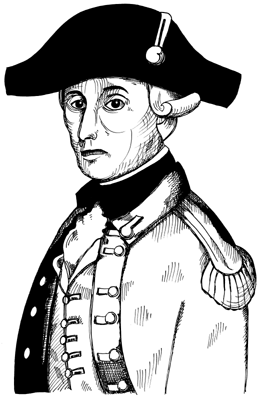
RBH Home
Maps & Travels
Articles
Legends
Towns & Villages
Castles & Houses
Churches
Biographies
Gentry
Family History
Odds & Ends
Mail David
 Col.
John Walsh
Col.
John Walsh(1726-1795)
Born: 1st July 1726 at Fort St. George, India
Secretary to the Governor of Bengal
Died: 9th March 1795
at Mayfair, Westminster, Middlesex
John Walsh, the secretary to Lord Clive and man of science, was the son of Joseph Walsh, Governor of Fort St. George, by his wife Elizabeth, daughter of Neville Muskelyne (1663-1711) of Purton in Wiltshire. Neville Maskelyne, the Royal Astronomer, and his sister, Margaret Maskelyne, who married Robert, 1st Baron Clive, were his first cousins. Like many of his relatives, Walsh entered the service of the East India Company (in 1742) and became paymaster of the troops at Madras. In 1757, Clive appointed Walsh his private secretary and he acted in this capacity throughout the campaign in Bengal of that year. Two years later, Clive commissioned him to return to London and lay before Pitt his project for reorganising the administration of Bengal, a subject of which he said Walsh was "a thorough master." In a letter, dated 26th November, Walsh gives Clive an account of his interview with Pitt.
Walsh now settled in England with an amassed fortune estimated at £140,000, purchasing, in 1761, the manor of Hockenhull in Cheshire. He sold it before long and acquired Warfield Park, near Bracknell, in Berkshire, in 1771. On 30th March 1761, he was returned to Parliament for Worcester, his object being mainly to form a parliamentary interest in Clive's support. However, he also, apparently, became a friend and supporter of John Wilkes - the Buckinghamshire gentleman and political opponent of the Earl of Bute - particularly in the infamous affair of the libeling issue 45 of his 'North Briton' newspaper. He retained his seat till 1780 and much of his correspondence with Clive is printed in Malcolm's 'Life of Clive' (1836). He also corresponded with Warren Hastings, but quarrelled with him in 1781 because of the dismissal of his nephew, Francis Fowke, from his post at Benares.
Walsh's main interests were, however, scientific and he was the first person to make accurate experiments on the torpedo fish. He was elected a fellow of the Royal Society on 8th November 1770, his certificate of election describing him as "a Gentleman well acquainted with philosophical, & polite literature, & particularly versed in the natural history and antiquities of India". A fellowship of the Society of Antiquaries followed
on 10th January 1771 and, on 1st July 1773, a letter from him to Benjamin Franklin, treating "of the electric property of the torpedo," was read before the Royal Society. In this paper, he, for the first time, conclusively demonstrated that the singular power of benumbing the sense of touch possessed by the fish was due to electrical influence and that it could only send a shock through conducting substances. On 23rd June 1774, a second letter by Walsh was read before the society, entitled 'Of torpedoes found on the coast of England'. It was addressed to Thomas Pennant, the author of 'British Zoology' and was published in pamphlet form. For these discoveries, the Royal Society awarded him the Copley medal in 1774. No further experiments were made until 1805, when Humboldt and Gay Lussac examined the properties of the torpedo at Naples; but the first investigator to make fresh discoveries on the subject was John Thomas Todd at the Cape of Good Hope in 1812.Walsh was returned to parliament for the city of Worcester on 30th March 1761 and retained his seat until 1780. He died, unmarried, some fifteen years later, on 9th March 1795 in London, at his residence in Chesterfield Street, although he was buried in the parish church in Warfield. He left his property, including Warfield Park, to Sir John Benn, who had married, in 1778, Margaret, daughter of Walsh's sister, Elizabeth. Benn assumed, in accordance with the provisions of the will, the additional name of Walsh, and was father of Sir John Benn-Walsh, 1st Baron Ormathwaite.
Edited
from Sidney Lee's 'Dictionary of National Biography' (1899).
Many thanks to Prof. Marco Piccolino for providing additional information,
particularly concerning Walsh's birth date and the inaccuracy of claims that he won a second
Copley Medal in 1783.
